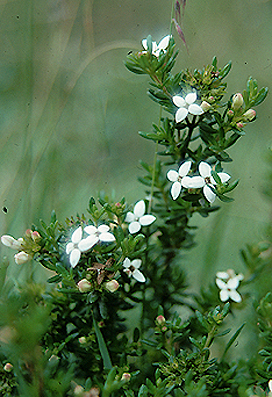Rubiaceae of the New World
By Piero Delprete and
Rocio Cortés
ARCYTOPHYLLUM Willdenow ex Schultes & Schultes
Rubiaceae of the New World
By Piero Delprete and
Rocio Cortés
ARCYTOPHYLLUM Willdenow ex Schultes & Schultes
|

Arcytophyllum thymifolium Cotopaxi, Ecuador Photo P. Delprete |
Synonyms: Anotis A. P. de Candolle; Anotis sect. Ereicoctis A. P. de Candolle; Arcythophyllum Schlechtendal (orth. ar.); Ereicoctis O. Kuntze (nomen); Mallostoma H. Karsten; Pseudorachicallis H. Karsten; Pseudorachicallis Post & O. Kuntze (nomen), Pseudorhachicallis J. D. Hooker (nomen), Pseudrachicallis Korthals (nomen); Teinosolen J. D. Hooker.
Prostrated or erect subshrubs to shrubs; raphides present; axillary thorns absent. Stipules interpetiolar, connate at base or sheathing (not plitting on one side), narrowly triangular, deltoid, triangular with tooth-like extensions, persistent. Leaves opposite, subsessil or sessil; blades ovate, elliptic, lanceolate or orbicular, thinly coriaceous; foliar pellucid glands absent; domatia absent. Inflorescence terminal, not frondose, cymose, pauciflorous to multiflorous, dichasiate or uniflorous. Flowers bisexual. Calyx tube absent, lobes connate at base, persistent, lobes 4 or 5, narrowly triangular, elliptic, ovate, minute. Calycophylls absent. Corolla hypocrateriform or broadly infundibuliform, actinomorphic, white to cream-white, pink, red, violet to purple; tube externally glabrous, internally glabrous or pubescent, with or without a pubescent ring at base inside; orifice annular thickening absent; lobes 4 or 5, valvate, deltoid, narrowly triangular or ovate, margin entire, acute at apex, short acuminate at apex. Stamens alternate to the corolla lobes, included, partially exserted (only tips exserted), exserted just beyond the corolla; anthers oblong, round at base, round at apex, dehiscing by longitudinal slits, dorsifixed near the base; filaments attached near the mouth of the corolla tube, free at base, filiform, short (anthers subsessil), equal, glabrous. Pollen released as monads. Style exserted just beyond the corolla or included, filiform throughout, glabrous; lobes 2, ovate. Ovary inferior, 2-locular, ovoid or globose; placentation axile, placenta stalked, inserted on the center of the septum, ovules 2 to many per locule. Fruit a septicidal capsule, dehiscing basipetally, the valves secondarily splitting at apex, chartaceous. Seeds horizontal, minute, laterally compressed, rounded in outline, spherical to ellipsoidal; wings absent or lateral, hemi-elliptic in outline.
Geographic distribution: Northern Central America (up to southern Mexico), southern Central America, Magdalena-Llanos area, northern Andes (above 1000 m), central Andes and southern intertropical Andes.
Number of species: 16.
References: P. Mena V., A revision of the genus Arcytophyllum
(Rubiaceae:
Hedyotideae). Mem. New York Bot. Gard. 60: 1–26. 1990; E. E. Terrell, Morphology
and taxonomy of Arcytophyllum serpyllaceum (Rubiaceae). Novon 9:
263–264. 1999.